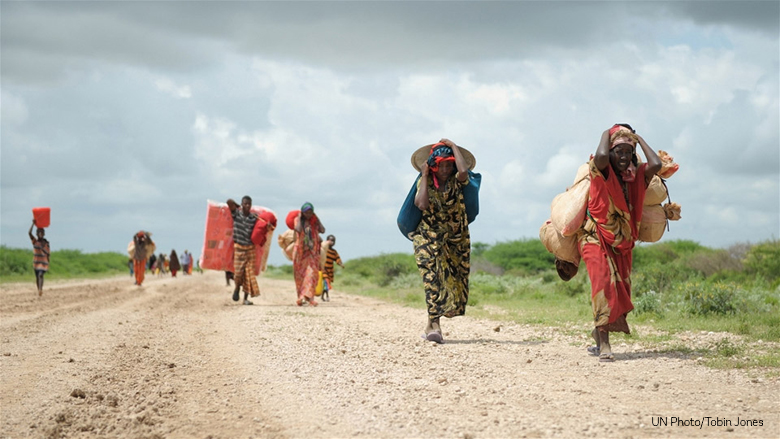WASHINGTON, June 20, 2017 – As the number of forcibly displaced continues to rise, there is clear recognition that development can play a significant role in responding to this challenge, in collaboration with humanitarian partners. Underpinning this new approach is the World Bank report, “Forcibly Displaced: Toward a Development Approach Supporting Refugees, Internally Displaced Persons and Their Hosts,” produced in close partnership with UNHCR.
The report examines available data to better understand the scope of the challenge, and reveals that the same 10 conflicts have accounted for the majority of the forcibly displaced every year since 1991, consistently hosted by about 15 countries – overwhelmingly in the developing world. The development approach focuses on tackling the medium-term social and economic dimensions of forced displacement, which complements emergency response and the rights-based agenda of humanitarian partners.
“Forced displacement is a development world crisis, with 95% of the global total of refugees and internally displaced persons hosted in low- and middle-income countries. Support is critical to achieve the Sustainable Development Goals and end extreme poverty,” said lead author of the report Xavier Devictor, Advisor, Fragility, Conflict and Violence Group, who manages the global forced displacement program at the World Bank. “The development approach aims to help the forcibly displaced to overcome their vulnerabilities such as loss of assets and lack of a planning horizon, so they can rebuild their lives with dignity. Host communities need help too, to manage the increased demand on services due to the arrival of large numbers of people.”
The report proposes a development agenda that focuses on:
- Preventing the negative impacts of forced displacement. Engage in a dialogue with the authorities of origin countries to support better policy choices, highlighting the high costs of forced displacement. Support regional initiatives to better manage cross-border movements. Help host countries prepare for predictable inflows.
- Strengthen the resilience of those who stay behind. Finance projects to maintain livelihoods and to strengthen community-based institutions, focusing on “stable parts of unstable countries.” Interventions should not be seen as a substitute to providing asylum.
- Supporting host communities. Address long-term development challenges, as well as scale up service delivery and facilitate a transition from relying on humanitarian aid to utilizing country systems. Encourage policies that provide the right to work and freedom of movement for the displaced, which can be a win-win for host communities. Displacement can be forecast, and there is time to prepare, for example with block grants that can be rapidly deployed to affected municipalities when the crisis hits.
- Helping the forcibly displaced. Promote self-reliance and access to jobs, create opportunities through private sector investment, provide adequate education services, and modernize social protection systems to humanitarian contexts.
- Working towards durable solutions. Support returnees and return communities (especially in urban areas) so that return can be successful, and help develop solutions to provide legal rights to de facto integrate people where feasible; and maintain support over the medium-term.
The Bank is taking this approach to the ground, working across countries that host large numbers of displaced people. Support aims to encourage countries to adopt progressive policies that enable refugees to work and become economically independent. This will in turn help them to integrate with host communities, providing a more sustainable way to address this growing crisis.
In middle-income countries, which host roughly six million refugees, international partners are providing support through the Global Concessional Financing Facility (GCFF), launched by the World Bank, United Nations and Islamic Development Bank. In just one year, it has unlocked more than $1 billion in concessional financing for seven Multilateral Development Bank projects that benefit both Syrian refugees and their host communities in Jordan and Lebanon. The Facility will also be able to help other middle-income host countries in the future, as well.
In low-income countries, Bank teams have completed missions to nine countries to help prepare for the implementation of the $2 billion IDA18 window for refugees and host communities. Despite the dire circumstances in many of these countries, the conversation with governments about their policies to manage refugees is changing – slowly but surely – towards helping them to work and become self-reliant.
In the long term, more needs to be done to help countries address fragility and conflict, to create more stable societies that provide opportunities for all, so that people will not need to risk their lives and flee in the first place.
